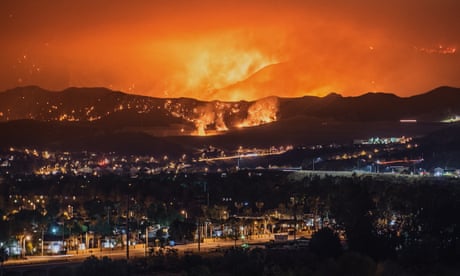
Tuesday’s strong winds stoked Dixie fire, which grew to over 395 sq miles across Plumas and Butte counties
California’s largest wildfire exploded again after burning for nearly three weeks in remote mountains, with officials warning that hot, dry weather threatened to further stoke the flames.
Officials warned that the high temperatures increase the risk of new fires across much of the state. “I think we definitely have a few hard days ahead of us,” said Shannon Prather with the US Forest Service.

Strong winds on Tuesday stoked the Dixie fire, which grew to over 395 sq miles (1,024 sq km) across Plumas and Butte counties. The blaze jumped perimeter lines in a few spots, prompting additional evacuation orders for about 15,000 people, fire officials said.
Heat from the flames also created a pyrocumulus cloud, a massive column of smoke that rose 30,000ft (10,000 yards) in the air, Mike Wink, a state fire operations section chief said.
Firefighters had been able to save homes and hold large stretches of the blaze in recent days, but a red flag warning was scheduled for Wednesday afternoon through Thursday because of hot, bone-dry conditions with winds up to 40 mph. That could drive flames through timber, brush and grass, especially along the northern and north-eastern sides of the vast wildfire.
Similar risky weather is expected across southern California, with heat advisories and warnings issued for interior valleys, mountains and deserts for much of the week.
The Dixie fire has threatened thousands of homes and destroyed 67 houses and other buildings since breaking out 14 July. It was 35% contained.
About 150 miles (240km) west of the Dixie fire, the lightning-sparked McFarland fire threatened remote homes along the Trinity River in the Shasta-Trinity national forest. That fire was only 5% contained, and is was burning fiercely through drought-stricken vegetation and had doubled in size every day, fire officials warned.
Heat waves and historic drought tied to climate change have made wildfires harder to fight in the American west. Scientists say climate change has made the region much warmer and drier in the past 30 years and will continue to make weather more extreme and wildfires more frequent and destructive.
Nearly a hundred large, active wildfires are burning across 13 US states, engaging more than 20,000 firefighters and support personnel.
California is battling 11 large active blazes. Montana has 25 and Idaho 21.
In southern Oregon, lightning struck parched forests hundreds of times in a 24-hour period, igniting 50 new wildfires. But firefighters and aircraft attacked the flames before they spread out of control and no homes were immediately threatened.
The state’s Bootleg fire, the nation’s largest at 647 sq miles (1,676 sq km), was 84% contained and firefighters were busy mopping up hotspots and strengthening fire lines.
“Crews are working tirelessly to ensure we are as prepared as we can be for the extreme fire weather forecast for the next couple days,“ a US Forest Service update said.
In Hawaii, firefighters on the Big Island in recent days gained control over the biggest brush fire that island has ever recorded. The Nation fire torched more than 62 sq miles (160 sq km), forcing thousands of people to evacuate and destroying two homes.
Mike Walker, the state fire protection forester for the department of land and natural resources, said the total area burned could end up being the most the state has ever seen.
“It is pretty significant,” he said, adding that sustained 30mph winds with gusts of up to 50mph drove the fire roughly 100 acres an hour through Saturday and Sunday.
Source: The Guardian